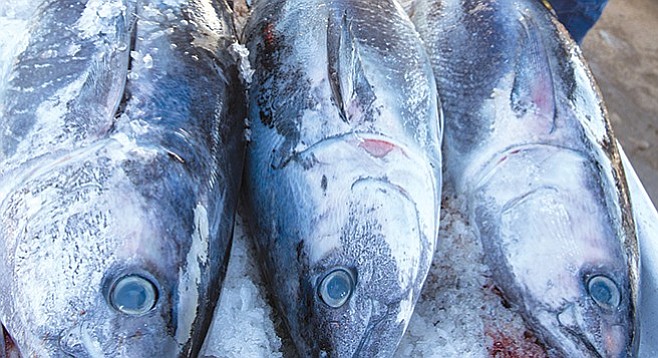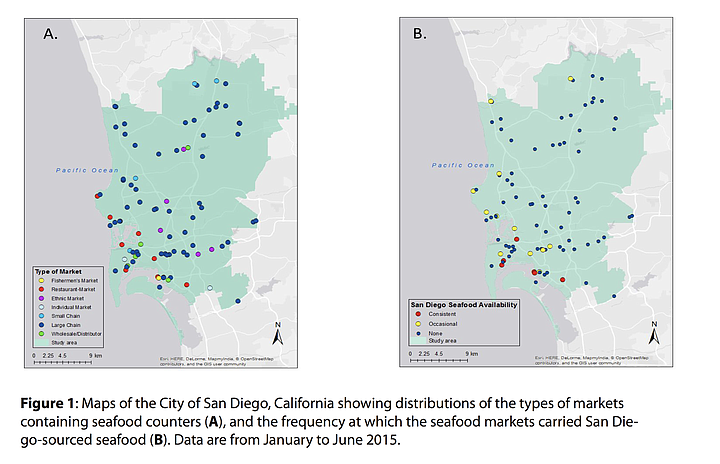 Facebook
Facebook
 X
X
 Instagram
Instagram
 TikTok
TikTok
 Youtube
Youtube

San Diegans could be eating more locally caught fresh fish, snails, squid, and lobsters, says a new study by academics from the Scripps Institution of Oceanography and USD, but globalization and a lack of reliable information about where the region's edible seafood actually comes from is getting in the way.
"A total of 86 seafood markets served the city of San Diego’s 1.3 million residents in the first half of 2015," says the August 29 paper in the Future of Food: Journal on Food, Agriculture and Society.

"Only 8% of seafood markets consistently carried San Diego–sourced seafood, while 14% carried it on occasion, or at least likely did."
Worse yet, "None of the ethnic markets and only 7% of large chain stores carried San Diego–sourced seafood; these two market types comprised 72% of all seafood markets in San Diego."
Purveyors of local seafood here tend to hug the shore, leaving the inland with no access to more esoteric delicacies. "79% of markets selling San Diego seafood (and 100% of markets selling San Diego seafood consistently) were located within just 2 [kilometers] of the coast."
In addition, would-be local seafood consumers who go looking for home-caught meals are often stymied by the products' fishy provenance.
"The source of seafood purchased by markets from a distributor was often uncertain," says the paper by Theresa Sinicrope Talley and Nina Venuti of Scripps and USD's Hannah Warde.
"If the market manager mentioned buying from a distributor who in turn had claimed to buy from San Diego fishermen, then we assumed that San Diego seafood was, by chance, at least occasionally available. This uncertainty revealed the need for improved traceability of the seafood supply chain and product source, if we hope to make informed decisions about seafood choices and local seafood systems."
The researchers also discovered that getting fish directly from the source is difficult if not virtually impossible here.
"There was only one fishermen’s market, and one fisherman who consistently sold at several of the city’s farmers' markets; these were the only venues where consumers could buy San Diego’s catch directly from producers," the study found.
Well-hyped efforts by local government to aid the fishing business here have been insufficient, the study asserts, citing, "a noted lack of waterfront infrastructure used for docking, offloading, maintaining boats and gear, holding and refrigerating catch, and direct marketing of catch along the San Diego coast."
According to the report, "Recent efforts have restored some waterfront infrastructure in San Diego, including provision of dock space for the fishermen’s market, as well as the replacement of one dock with a new crane and hoist, and the installation of an ice machine and a live holding tank. These upgrades are, however, relatively few given the size and needs of the fleet, controlled by non-fishermen entities, and installed in a location where few commercial fishermen dock."
San Diego is not alone in its dependence on foreign fish, say the authors.
"About 90% of the seafood consumed in the United States is imported from overseas…. Some San Diego fishermen testified that only 20 to 25% of their catch stays in San Diego."
Added the report, “a recent study revealed that 95 to 99% of San Diego–caught California spiny lobster and 90% of market squid are shipped abroad, primarily to the Chinese market.”
Another problem is lack of popular familiarity with local palate-friendly ocean species, including varieties of snails and squid.
"The significant difference between the seafood species that are regularly consumed by San Diegans, and the species that are caught by San Diego fishermen, likely contributes to the low consumption of local seafood," the study notes.
"San Diego fisheries include some mainstream species, including higher trophic level finfish like tuna and swordfish, but also many less well-known fisheries (invertebrates such as Kellet’s whelk and wavy turban snail, and coastal ground fish and pelagics, such as rock fish, sable-fish, and Pacific mackerel).
Note the researchers: "The very narrow San Diego seafood diet —compounded by prevalent, inexpensive imports of mainstream species — results in an egregious lack of awareness of the species landed locally."


San Diegans could be eating more locally caught fresh fish, snails, squid, and lobsters, says a new study by academics from the Scripps Institution of Oceanography and USD, but globalization and a lack of reliable information about where the region's edible seafood actually comes from is getting in the way.
"A total of 86 seafood markets served the city of San Diego’s 1.3 million residents in the first half of 2015," says the August 29 paper in the Future of Food: Journal on Food, Agriculture and Society.

"Only 8% of seafood markets consistently carried San Diego–sourced seafood, while 14% carried it on occasion, or at least likely did."
Worse yet, "None of the ethnic markets and only 7% of large chain stores carried San Diego–sourced seafood; these two market types comprised 72% of all seafood markets in San Diego."
Purveyors of local seafood here tend to hug the shore, leaving the inland with no access to more esoteric delicacies. "79% of markets selling San Diego seafood (and 100% of markets selling San Diego seafood consistently) were located within just 2 [kilometers] of the coast."
In addition, would-be local seafood consumers who go looking for home-caught meals are often stymied by the products' fishy provenance.
"The source of seafood purchased by markets from a distributor was often uncertain," says the paper by Theresa Sinicrope Talley and Nina Venuti of Scripps and USD's Hannah Warde.
"If the market manager mentioned buying from a distributor who in turn had claimed to buy from San Diego fishermen, then we assumed that San Diego seafood was, by chance, at least occasionally available. This uncertainty revealed the need for improved traceability of the seafood supply chain and product source, if we hope to make informed decisions about seafood choices and local seafood systems."
The researchers also discovered that getting fish directly from the source is difficult if not virtually impossible here.
"There was only one fishermen’s market, and one fisherman who consistently sold at several of the city’s farmers' markets; these were the only venues where consumers could buy San Diego’s catch directly from producers," the study found.
Well-hyped efforts by local government to aid the fishing business here have been insufficient, the study asserts, citing, "a noted lack of waterfront infrastructure used for docking, offloading, maintaining boats and gear, holding and refrigerating catch, and direct marketing of catch along the San Diego coast."
According to the report, "Recent efforts have restored some waterfront infrastructure in San Diego, including provision of dock space for the fishermen’s market, as well as the replacement of one dock with a new crane and hoist, and the installation of an ice machine and a live holding tank. These upgrades are, however, relatively few given the size and needs of the fleet, controlled by non-fishermen entities, and installed in a location where few commercial fishermen dock."
San Diego is not alone in its dependence on foreign fish, say the authors.
"About 90% of the seafood consumed in the United States is imported from overseas…. Some San Diego fishermen testified that only 20 to 25% of their catch stays in San Diego."
Added the report, “a recent study revealed that 95 to 99% of San Diego–caught California spiny lobster and 90% of market squid are shipped abroad, primarily to the Chinese market.”
Another problem is lack of popular familiarity with local palate-friendly ocean species, including varieties of snails and squid.
"The significant difference between the seafood species that are regularly consumed by San Diegans, and the species that are caught by San Diego fishermen, likely contributes to the low consumption of local seafood," the study notes.
"San Diego fisheries include some mainstream species, including higher trophic level finfish like tuna and swordfish, but also many less well-known fisheries (invertebrates such as Kellet’s whelk and wavy turban snail, and coastal ground fish and pelagics, such as rock fish, sable-fish, and Pacific mackerel).
Note the researchers: "The very narrow San Diego seafood diet —compounded by prevalent, inexpensive imports of mainstream species — results in an egregious lack of awareness of the species landed locally."
Comments